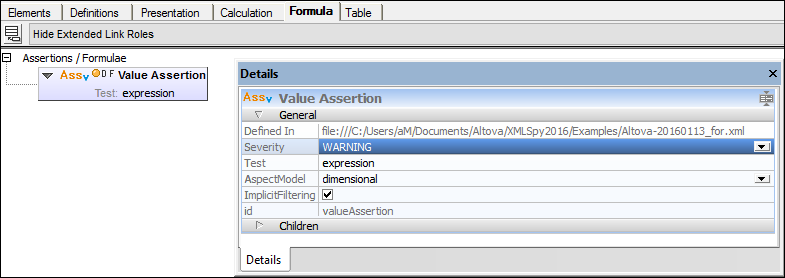Assertions and Assertion Sets
There are three types of assertions:
•Value Assertions
•Existence Assertions
•Consistency Assertions
Value assertions
Value assertions are the most used formula linkbase feature, providing a way to check input XBRL instance facts against an XPath expression. It provides the properties Aspect Model and Implicit Filtering as icons. The value of the property test is an XPath expression.
Existence assertions
An existence assertion is useful for checks of static existence, such as to assure that document descriptive facts such as form type, company identification, and filing identification are present. It provides the properties Aspect Model and Implicit Filtering as icons. The value of the property test is an XPath expression.
Consistency assertions
A consistency assertion specifies how to determine whether an output fact, produced by the associated formula, is consistent with all aspect matched facts in the input XBRL instance. It provides the Boolean property strict as an icon. The values of the properties Absolute Acceptance Radius and Proportional Acceptance Radius are XPath expressions.
Assertion satisfied/unsatisfied messages
These sub-components of assertions enable the association of messages with assertion evaluations: satisfied messages with successful evaluations, unsatisfied messages with unsuccessful messages. These messages can be added via the context menu of individual assertions.
Assertion-unsatisfied-severity relationships
An assertion is either satisfied or unsatisfied. However, since assertions have rules that are of a different importance level, unsatisfied assertions are classified according to the severity of that particular assertion non-satisfaction. There are three standard severity levels: ERROR, WARNING, and OK. The default severity is ERROR. It is invoked when an assertion is not associated with a defined severity.
The assertion-unsatisfied-severity relationship is between an assertion and one of the defined severity resources. It is expressed by an XLink arc with: (i) an arcrole value of http://xbrl.org/arcrole/PR/2015-11-180/assertion-unsatisfied-severity, (ii) an assertion as its start resource; and (iii) a severity resource as its end resource.
In the Taxonomy Editor, the severity relationship can be specified by clicking the Severity icon of the Assertion component in the diagram (see screenshot below), and then selecting the severity level from the popup that appears. Alternatively, the severity level can be selected in the Detail entry helper of the Assertion (see screenshot).

Assertion Sets
An assertion set contains one or more assertions. The context menu of an assertion set allows the addition of individual assertions to the assertion set.